| Listing 1 - 10 of 13 | << page >> |
Sort by
|
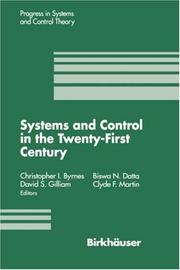
ISBN: 0817638814 9780817638818 3764338814 146128662X 1461241200 9783764338817 Year: 1997 Volume: 22 Publisher: Boston, Mass. Birkhäuser
Abstract | Keywords | Export | Availability | Bookmark
 Loading...
Loading...Choose an application
- Reference Manager
- EndNote
- RefWorks (Direct export to RefWorks)
The mathematical theory of networks and systems has a long, and rich history, with antecedents in circuit synthesis and the analysis, design and synthesis of actuators, sensors and active elements in both electrical and mechanical systems. Fundamental paradigms such as the state-space real ization of an input/output system, or the use of feedback to prescribe the behavior of a closed-loop system have proved to be as resilient to change as were the practitioners who used them. This volume celebrates the resiliency to change of the fundamental con cepts underlying the mathematical theory of networks and systems. The articles presented here are among those presented as plenary addresses, invited addresses and minisymposia presented at the 12th International Symposium on the Mathematical Theory of Networks and Systems, held in St. Louis, Missouri from June 24 - 28, 1996. Incorporating models and methods drawn from biology, computing, materials science and math ematics, these articles have been written by leading researchers who are on the vanguard of the development of systems, control and estimation for the next century, as evidenced by the application of new methodologies in distributed parameter systems, linear nonlinear systems and stochastic sys tems for solving problems in areas such as aircraft design, circuit simulation, imaging, speech synthesis and visionics.
Mathematical control systems --- System analysis --- Control theory --- Congresses. --- -System analysis --- -#TELE:SISTA --- Network theory --- Systems analysis --- System theory --- Mathematical optimization --- Dynamics --- Machine theory --- Congresses --- Conferences - Meetings --- System theory. --- Systems Theory, Control. --- Systems, Theory of --- Systems science --- Science --- Philosophy --- System analysis - Congresses. --- Control theory - Congresses
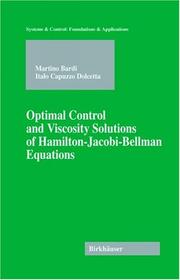
ISBN: 0817636404 3764336404 0817647546 0817647554 9780817647551 9780817636401 9783764336400 Year: 1997 Publisher: Boston, Mass. Birkhäuser
Abstract | Keywords | Export | Availability | Bookmark
 Loading...
Loading...Choose an application
- Reference Manager
- EndNote
- RefWorks (Direct export to RefWorks)
This book is a self-contained account of the theory of viscosity solutions for first-order partial differential equations of Hamilton–Jacobi type and its interplay with Bellman’s dynamic programming approach to optimal control and differential games, as it developed after the beginning of the 1980s with the pioneering work of M. Crandall and P.L. Lions. The book will be of interest to scientists involved in the theory of optimal control of deterministic linear and nonlinear systems. In particular, it will appeal to system theorists wishing to learn about a mathematical theory providing a correct framework for the classical method of dynamic programming as well as mathematicians interested in new methods for first-order nonlinear PDEs. The work may be used by graduate students and researchers in control theory both as an introductory textbook and as an up-to-date reference book. "The exposition is self-contained, clearly written and mathematically precise. The exercises and open problems…will stimulate research in the field. The rich bibliography (over 530 titles) and the historical notes provide a useful guide to the area." — Mathematical Reviews "With an excellent printing and clear structure (including an extensive subject and symbol registry) the book offers a deep insight into the praxis and theory of optimal control for the mathematically skilled reader. All sections close with suggestions for exercises…Finally, with more than 500 cited references, an overview on the history and the main works of this modern mathematical discipline is given." — ZAA "The minimal mathematical background...the detailed and clear proofs, the elegant style of presentation, and the sets of proposed exercises at the end of each section recommend this book, in the first place, as a lecture course for graduate students and as a manual for beginners in the field. However, this status is largely extended by the presence of many advanced topics and results by the fairly comprehensive and up-to-date bibliography and, particularly, by the very pertinent historical and bibliographical comments at the end of each chapter. In my opinion, this book is yet another remarkable outcome of the brilliant Italian School of Mathematics." — Zentralblatt MATH "The book is based on some lecture notes taught by the authors at several universities...and selected parts of it can be used for graduate courses in optimal control. But it can be also used as a reference text for researchers (mathematicians and engineers)...In writing this book, the authors lend a great service to the mathematical community providing an accessible and rigorous treatment of a difficult subject." — Acta Applicandae Mathematicae.
Mathematical control systems --- Viscosity solutions --- Control theory --- Differential games --- System theory. --- Mathematical optimization. --- Partial differential equations. --- Systems Theory, Control. --- Optimization. --- Partial Differential Equations. --- Partial differential equations --- Optimization (Mathematics) --- Optimization techniques --- Optimization theory --- Systems optimization --- Mathematical analysis --- Maxima and minima --- Operations research --- Simulation methods --- System analysis --- Systems, Theory of --- Systems science --- Science --- Philosophy
Book
ISBN: 3540108327 0387108327 3540387188 Year: 1981 Publisher: Berlin : Springer-Verl.,
Abstract | Keywords | Export | Availability | Bookmark
 Loading...
Loading...Choose an application
- Reference Manager
- EndNote
- RefWorks (Direct export to RefWorks)
Stochastic processes --- 519.2 --- Probability. Mathematical statistics --- Stochastic processes. --- 519.2 Probability. Mathematical statistics --- Mathematics. --- System theory. --- Calculus of variations. --- Systems Theory, Control. --- Calculus of Variations and Optimal Control; Optimization. --- Systems theory. --- Mathematical optimization. --- Processus stochastiques --- Markov, Processus de --- Analyse stochastique --- Integrales stochastiques
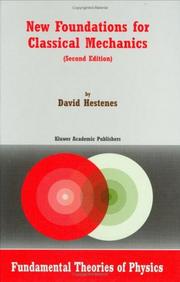
ISBN: 0792355148 0792353021 0306471221 Year: 1999 Volume: 99 Publisher: Dordrecht, Netherlands ; Boston, Massachusetts : Kluwer Academic Publishers,
Abstract | Keywords | Export | Availability | Bookmark
 Loading...
Loading...Choose an application
- Reference Manager
- EndNote
- RefWorks (Direct export to RefWorks)
(revised) This is a textbook on classical mechanics at the intermediate level, but its main purpose is to serve as an introduction to a new mathematical language for physics called geometric algebra. Mechanics is most commonly formulated today in terms of the vector algebra developed by the American physicist J. Willard Gibbs, but for some applications of mechanics the algebra of complex numbers is more efficient than vector algebra, while in other applications matrix algebra works better. Geometric algebra integrates all these algebraic systems into a coherent mathematical language which not only retains the advantages of each special algebra but possesses powerful new capabilities. This book covers the fairly standard material for a course on the mechanics of particles and rigid bodies. However, it will be seen that geometric algebra brings new insights into the treatment of nearly every topic and produces simplifications that move the subject quickly to advanced levels. That has made it possible in this book to carry the treatment of two major topics in mechanics well beyond the level of other textbooks. A few words are in order about the unique treatment of these two topics, namely, rotational dynamics and celestial mechanics.
mechanica --- Algebraic geometry --- Mathematical physics --- Classical mechanics. Field theory --- Mechanics. --- Mécanique --- EPUB-LIV-FT SPRINGER-B --- Physics. --- Algebraic geometry. --- System theory. --- Observations, Astronomical. --- Astronomy --- Astronomy, Observations and Techniques. --- Algebraic Geometry. --- Systems Theory, Control. --- Observations. --- Geometry, algebraic. --- Systems theory. --- Classical Mechanics. --- Astronomy—Observations. --- Systems, Theory of --- Systems science --- Science --- Classical mechanics --- Newtonian mechanics --- Physics --- Dynamics --- Quantum theory --- Geometry --- Astronomical observations --- Observations, Astronomical --- Philosophy
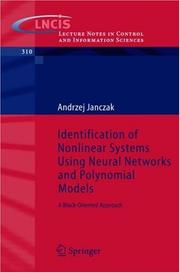
ISBN: 3540231854 3540315969 Year: 2005 Publisher: Berlin, Heidelberg : Springer Berlin Heidelberg : Imprint: Springer,
Abstract | Keywords | Export | Availability | Bookmark
 Loading...
Loading...Choose an application
- Reference Manager
- EndNote
- RefWorks (Direct export to RefWorks)
This monograph systematically presents the existing identification methods of nonlinear systems using the block-oriented approach It surveys various known approaches to the identification of Wiener and Hammerstein systems which are applicable to both neural network and polynomial models. The book gives a comparative study of their gradient approximation accuracy, computational complexity, and convergence rates and furthermore presents some new and original methods concerning the model parameter adjusting with gradient-based techniques. "Identification of Nonlinear Systems Using Neural Networks and Polynomal Models" is useful for researchers, engineers and graduate students in nonlinear systems and neural network theory.
Mathematical control systems --- Artificial intelligence. Robotics. Simulation. Graphics --- Engineering. --- System theory. --- Statistical physics. --- Dynamical systems. --- Vibration. --- Dynamics. --- Control engineering. --- Robotics. --- Mechatronics. --- Control, Robotics, Mechatronics. --- Vibration, Dynamical Systems, Control. --- Systems Theory, Control. --- Statistical Physics, Dynamical Systems and Complexity. --- Complex Systems. --- Statistical Physics and Dynamical Systems. --- Cycles --- Mechanics --- Sound --- Physics --- Mathematical statistics --- Systems, Theory of --- Systems science --- Science --- Statistical methods --- Philosophy --- Systems theory. --- Dynamical systems --- Kinetics --- Mathematics --- Mechanics, Analytic --- Force and energy --- Statics --- Mechanical engineering --- Microelectronics --- Microelectromechanical systems --- Automation --- Machine theory --- Control engineering --- Control equipment --- Control theory --- Engineering instruments --- Programmable controllers

ISBN: 3540669051 3642570143 Year: 2000 Publisher: Berlin : Springer-Verl.,
Abstract | Keywords | Export | Availability | Bookmark
 Loading...
Loading...Choose an application
- Reference Manager
- EndNote
- RefWorks (Direct export to RefWorks)
The 9th Belgian-French-German Conference on Optimization has been held in Namur (Belgium) on September 7-11, 1998. This volume is a collection of papers presented at this Conference. Originally, this Conference was a French-German Conference but this year, in accordance with the organizers' wishes, a third country, Belgium, has joined the founding members of the Conference. Hence the name: Belgian French-German Conference on Optimization. Since the very beginning, the purpose of these Conferences has been to bring together researchers working in the area of Optimization and partic ularly to encourage young researchers to present their work. Most of the participants come from the organizing countries. However the general ten dancy is to invite outside researchers to attend the meeting. So this year, among the 101 participants at this Conference, twenty researchers came from other countries. The general theme of the Conference is everything that concerns the area of Optimization without specification of particular topics. So theoretical as pects of Optimization, in addition to applications and algorithms of Opti mization, will be developed. However, and this point was very important for the organizers, the Conference must retain its convivial character. No more than two parallel sessions are organized. This would allow useful contacts between researchers to be promoted. The editors express their sincere thanks to all those who took part in this Conference. Their invaluable discussions have made this volume possible.
Mathematical statistics --- Mathematical optimization --- Civil & Environmental Engineering --- Engineering & Applied Sciences --- Operations Research --- AA / International- internationaal --- 305.976 --- NBB congres --- Algoritmen. Optimisatie. --- Conferences - Meetings --- Algoritmen. Optimisatie --- Operations research. --- Decision making. --- Calculus of variations. --- System theory. --- Operations Research/Decision Theory. --- Calculus of Variations and Optimal Control; Optimization. --- Systems Theory, Control. --- Systems, Theory of --- Systems science --- Science --- Isoperimetrical problems --- Variations, Calculus of --- Maxima and minima --- Deciding --- Decision (Psychology) --- Decision analysis --- Decision processes --- Making decisions --- Management --- Management decisions --- Choice (Psychology) --- Problem solving --- Operational analysis --- Operational research --- Industrial engineering --- Management science --- Research --- System theory --- Philosophy --- Decision making --- Programmation (mathématiques)
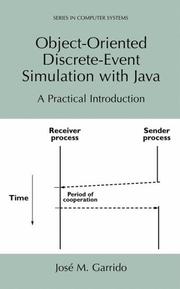
ISBN: 0306466880 1461354951 1461513197 Year: 2001 Publisher: New York, N.Y. Kluwer Academic/ Plenum Publishers
Abstract | Keywords | Export | Availability | Bookmark
 Loading...
Loading...Choose an application
- Reference Manager
- EndNote
- RefWorks (Direct export to RefWorks)
Researches and developers of simulation models state that the Java program ming language presents a unique and significant opportunity for important changes in the way we develop simulation models today. The most important characteristics of the Java language that are advantageous for simulation are its multi-threading capabilities, its facilities for executing programs across the Web, and its graphics facilities. It is feasible to develop compatible and reusable simulation components that will facilitate the construction of newer and more complex models. This is possible with Java development environments. Another important trend that begun very recently is web-based simulation, i.e., and the execution of simulation models using Internet browser software. This book introduces the application of the Java programming language in discrete-event simulation. In addition, the fundamental concepts and prac tical simulation techniques for modeling different types of systems to study their general behavior and their performance are introduced. The approaches applied are the process interaction approach to discrete-event simulation and object-oriented modeling. Java is used as the implementation language and UML as the modeling language. The first offers several advantages compared to C++, the most important being: thread handling, graphical user interfaces (QUI) and Web computing. The second language, UML (Unified Modeling Language) is the standard notation used today for modeling systems as a collection of classes, class relationships, objects, and object behavior.
Programming --- Computer programming. --- Software engineering. --- Computer simulation. --- System theory. --- Programming languages (Electronic computers). --- Mathematical models. --- Programming Techniques. --- Software Engineering. --- Simulation and Modeling. --- Systems Theory, Control. --- Programming Languages, Compilers, Interpreters. --- Mathematical Modeling and Industrial Mathematics. --- Models, Mathematical --- Simulation methods --- Computer languages --- Computer program languages --- Computer programming languages --- Machine language --- Electronic data processing --- Languages, Artificial --- Systems, Theory of --- Systems science --- Science --- Computer modeling --- Computer models --- Modeling, Computer --- Models, Computer --- Simulation, Computer --- Electromechanical analogies --- Mathematical models --- Model-integrated computing --- Computer software engineering --- Engineering --- Computers --- Electronic computer programming --- Electronic digital computers --- Programming (Electronic computers) --- Coding theory --- Philosophy
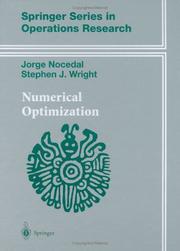
ISBN: 0387987932 9786610010677 1280010673 0387227423 9780387987934 Year: 1999 Publisher: New York : Springer,
Abstract | Keywords | Export | Availability | Bookmark
 Loading...
Loading...Choose an application
- Reference Manager
- EndNote
- RefWorks (Direct export to RefWorks)
This is a book for people interested in solving optimization problems. Because of the wide (and growing) use of optimization in science, engineering, economics, and industry, it is essential for students and practitioners alike to develop an understanding of optimization algorithms. Knowledge of the capabilities and limitations of these algorithms leads to a better understanding of their impact on various applications, and points the way to future research on improving and extending optimization algorithms and software. Our goal in this book is to give a comprehensive description of the most powerful, state-of-the-art, techniques for solving continuous optimization problems. By presenting the motivating ideas for each algorithm, we try to stimulate the reader’s intuition and make the technical details easier to follow. Formal mathematical requirements are kept to a minimum. Because of our focus on continuous problems, we have omitted discussion of important optimization topics such as discrete and stochastic optimization.
519.853 --- 519.65 --- Mathematical optimization --- #TELE:SISTA --- Optimization (Mathematics) --- Optimization techniques --- Optimization theory --- Systems optimization --- 519.65 Approximation. Interpolation --- Approximation. Interpolation --- 519.853 Nonlinear programming. Relaxation methods --- Nonlinear programming. Relaxation methods --- Mathematical optimization. --- Numerical methods of optimisation --- Mathematics. --- Operations research. --- Decision making. --- System theory. --- Calculus of variations. --- Calculus of Variations and Optimal Control; Optimization. --- Systems Theory, Control. --- Operation Research/Decision Theory. --- Mathematical analysis --- Maxima and minima --- Operations research --- Simulation methods --- System analysis --- Systems theory. --- Operations Research/Decision Theory. --- Deciding --- Decision (Psychology) --- Decision analysis --- Decision processes --- Making decisions --- Management --- Management decisions --- Choice (Psychology) --- Problem solving --- Operational analysis --- Operational research --- Industrial engineering --- Management science --- Research --- System theory --- Systems, Theory of --- Systems science --- Science --- Isoperimetrical problems --- Variations, Calculus of --- Decision making --- Philosophy --- Programmation (mathématiques) --- Programmation mathematique --- Methodes numeriques

ISBN: 1280312343 9786610312344 1846281784 185233956X 1849969760 Year: 2005 Publisher: London : Springer London : Imprint: Springer,
Abstract | Keywords | Export | Availability | Bookmark
 Loading...
Loading...Choose an application
- Reference Manager
- EndNote
- RefWorks (Direct export to RefWorks)
Models of dynamical systems are of great importance in almost all fields of science and engineering and specifically in control, signal processing and information science. A model is always only an approximation of a real phenomenon so that having an approximation theory which allows for the analysis of model quality is a substantial concern. The use of rational orthogonal basis functions to represent dynamical systems and stochastic signals can provide such a theory and underpin advanced analysis and efficient modelling. It also has the potential to extend beyond these areas to deal with many problems in circuit theory, telecommunications, systems, control theory and signal processing. Nine international experts have contributed to this work to produce thirteen chapters that can be read independently or as a comprehensive whole with a logical line of reasoning: • Construction and analysis of generalized orthogonal basis function model structure; • System Identification in a time domain setting and related issues of variance, numerics, and uncertainty bounding; • System identification in the frequency domain; • Design issues and optimal basis selection; • Transformation and realization theory. Modelling and Identification with Rational Orthogonal Basis Functions affords a self-contained description of the development of the field over the last 15 years, furnishing researchers and practising engineers working with dynamical systems and stochastic processes with a standard reference work.
Functions, Orthogonal. --- Linear systems --- Mathematical models. --- Systems, Linear --- Differential equations, Linear --- System theory --- Orthogonal functions --- Fourier analysis --- Series, Orthogonal --- Mathematical control systems --- Harmonic analysis. Fourier analysis --- System theory. --- Computer simulation. --- Control and Systems Theory. --- Systems Theory, Control. --- Simulation and Modeling. --- Signal, Image and Speech Processing. --- Computer modeling --- Computer models --- Modeling, Computer --- Models, Computer --- Simulation, Computer --- Electromechanical analogies --- Mathematical models --- Simulation methods --- Model-integrated computing --- Systems, Theory of --- Systems science --- Science --- Philosophy --- Systems theory. --- Control engineering. --- Signal processing. --- Image processing. --- Speech processing systems. --- Computational linguistics --- Electronic systems --- Information theory --- Modulation theory --- Oral communication --- Speech --- Telecommunication --- Singing voice synthesizers --- Control engineering --- Control equipment --- Control theory --- Engineering instruments --- Automation --- Programmable controllers --- Pictorial data processing --- Picture processing --- Processing, Image --- Imaging systems --- Optical data processing --- Processing, Signal --- Information measurement --- Signal theory (Telecommunication)

ISBN: 0306462923 1461371813 1461548136 9780306462924 Year: 1999 Publisher: New York, N.Y. Kluwer Academic/Plenum Publishers
Abstract | Keywords | Export | Availability | Bookmark
 Loading...
Loading...Choose an application
- Reference Manager
- EndNote
- RefWorks (Direct export to RefWorks)
The volume is based on the papers that were presented at the Interna tional Conference Model-Based Reasoning in Scientific Discovery (MBR'98), held at the Collegio Ghislieri, University of Pavia, Pavia, Italy, in December 1998. The papers explore how scientific thinking uses models and explanatory reasoning to produce creative changes in theories and concepts. The study of diagnostic, visual, spatial, analogical, and temporal rea soning has demonstrated that there are many ways of performing intelligent and creative reasoning that cannot be described with the help only of tradi tional notions of reasoning such as classical logic. Traditional accounts of scientific reasoning have restricted the notion of reasoning primarily to de ductive and inductive arguments. Understanding the contribution of model ing practices to discovery and conceptual change in science requires ex panding scientific reasoning to include complex forms of creative reasoning that are not always successful and can lead to incorrect solutions. The study of these heuristic ways of reasoning is situated at the crossroads of philoso phy, artificial intelligence, cognitive psychology, and logic; that is, at the heart of cognitive science. There are several key ingredients common to the various forms of model based reasoning to be considered in this book. The models are intended as in terpretations of target physical systems, processes, phenomena, or situations. The models are retrieved or constructed on the basis of potentially satisfying salient constraints of the target domain.
Science --- Discoveries in science --- Qualitative reasoning --- Methodology --- Philosophy of science --- Computer simulation. --- Philosophy and science. --- System theory. --- Logic. --- Artificial intelligence. --- Cognitive psychology. --- Simulation and Modeling. --- Philosophy of Science. --- Systems Theory, Control. --- Artificial Intelligence. --- Cognitive Psychology. --- Psychology, Cognitive --- Cognitive science --- Psychology --- AI (Artificial intelligence) --- Artificial thinking --- Electronic brains --- Intellectronics --- Intelligence, Artificial --- Intelligent machines --- Machine intelligence --- Thinking, Artificial --- Bionics --- Digital computer simulation --- Electronic data processing --- Logic machines --- Machine theory --- Self-organizing systems --- Simulation methods --- Fifth generation computers --- Neural computers --- Argumentation --- Deduction (Logic) --- Deductive logic --- Dialectic (Logic) --- Logic, Deductive --- Intellect --- Philosophy --- Reasoning --- Thought and thinking --- Systems, Theory of --- Systems science --- Science and philosophy --- Computer modeling --- Computer models --- Modeling, Computer --- Models, Computer --- Simulation, Computer --- Electromechanical analogies --- Mathematical models --- Model-integrated computing --- Artificial intelligence --- Breakthroughs, Scientific --- Discoveries, Scientific --- Scientific breakthroughs --- Scientific discoveries --- Creative ability in science --- Research --- Science - Methodology - Congresses --- Discoveries in science - Congresses --- Qualitative reasoning - Congresses
| Listing 1 - 10 of 13 | << page >> |
Sort by
|

 Search
Search Feedback
Feedback About
About Help
Help News
News